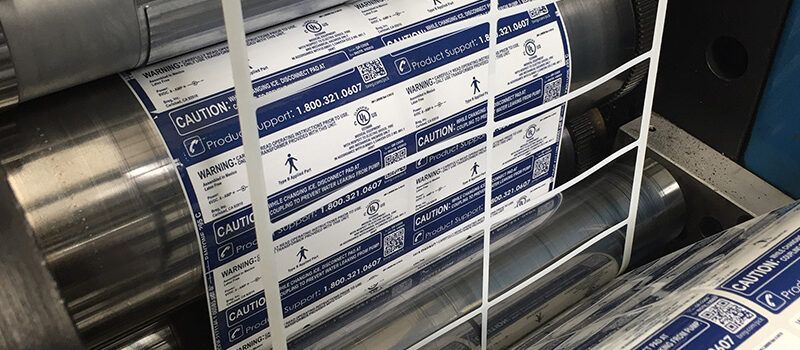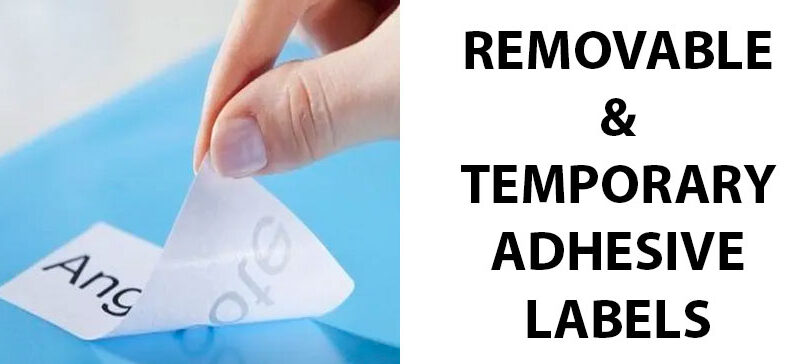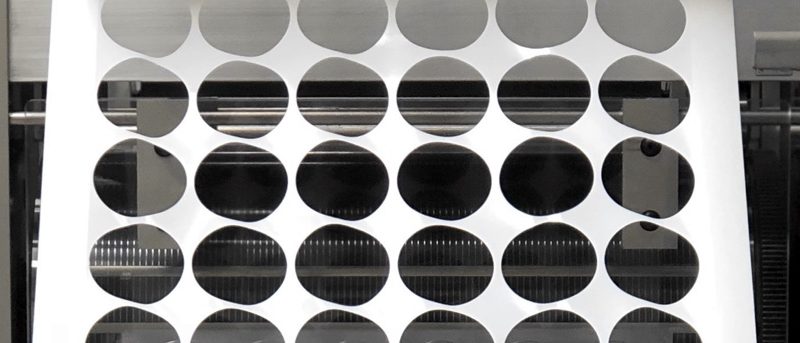Most of us have heard the term “die cutting” but still may not know exactly what it is. So, what is die cutting and what is it used for? Die-cutting simply refers to the process in which a machine mass produces and cuts out shapes. This fabrication process uses specialized tools and equipment to convert materials such as paper, polyester, VHB, foam, and adhesive into custom shapes and designs. Die-cutting is an important part of designing and creating custom labels.
Die Cut Printing
At its core, just like a printing process, die-cutting is an automated operation that allows multiples of the same shape to be created efficiently. With repeatability, die-cutting also offers precision. Tight tolerance which would be difficult to reproduce by hand becomes possible. On top of this, add the ability to now add functional contours, holes, and inner cuts and you have a powerful tool for custom products such as labels, tags, or VHB adhesive.
Different Types of Die Cutting
Some manufacturing applications are better suited for certain die-cutting processes over others. While each process has its advantages and disadvantages, the specifications of a particular die-cutting project such as costs, sizing, materials, and turnaround time all help in determining which process is right for your needs. Here are some of the most common methods:
-
Flatbed Die Cutting
Flatbed die-cutting is a fabrication process in which a flat sheet (usually plywood) is embedded with sharp strips of metal called steel rule. This is why the cutting die is alternately referred to as either a flatbed die or steel rule die. How the steel rule is set into the plywood determines the custom designs and shapes. Hydraulic presses are then used to press the die down into the chosen substrate. This process is suitable for cutting a wide range of materials such as plastic, paper, rubber, leather, metal, and laminates. That said, flatbed die cutting typically is a better fit when working with very thick materials or short runs.
-
Rotary and Semi-Rotary Die Cutting
With rotary and semi-rotary die-cutting, custom manufactured cylindrical dies are used to convert or die-cut flexible material. The processes for both are similar, with the main difference of how the die-cutting cavities are spaced. With rotary die-cutting, the die-cutting cavity makes up the entire circumference of the tool, while with a semi-rotary die-cutting there is a cutting void which the equipment accounts for with electronics and servos.
The tooling is precision machine engraved out of a metal cylinder or a flexible metal sheet that can then be wrapped around a magnetic cylinder. Both rotary and semi-rotary methods can use either solid or flexible dies. There are benefits and trade-offs for both types of dies. Solid dies have deeper cavities that can handle thicker materials such as Lexan, foam, and VHB. While the thinner flexible dies quicker and less expensive to manufacture, reducing tooling costs.
Both rotary and semi-rotary processes will be the quickest of the die-cutting methods and excel even over longer volume runs.
-
Laser Die Cutting
Laser die-cutting is pretty much exactly how it sounds. Essentially a type of plotter cutter, this method uses a laser instead of a knife. This process involves using a high-speed laser to cut through your chosen material. Lasers don’t require any actual contact with the material and can make a variety of cuts.
Laser cutters can often make intricate and detailed cuts. They also match up well with a wide variety of materials but have some limitations—no vinyl for example. This process usually has faster setup times, but slower top speed compared to rotary and semi-rotary. Also depending on how the laser is actuated, there may be limitations on thickness to chamfered edges.
Die-Cut Labels
With labels, there is more to consider than just shape. The label material is normally comprised of three specific layers. From top to bottom, the top layer is referred to as the face. Next is the adhesive, and finally a silicone liner on the bottom. When the label material is fed or moved through the cutting press, the die cuts through both the face and the adhesive but leaves the liner intact—a process that is known as kiss cutting. Depending on your needs, die-cutting can be used to cut various levels of depth creating different effects that can be used on your custom labels.
Conclusion
If you have a project that requires die-cutting of labels, adhesives, foams, or VHB, please give the specialists at Coast Label a call and we can help you navigate the various options available to you.
We use only industrial-grade materials from the best suppliers in the world and our quality is guaranteed. If the product you receive doesn’t meet our agreed-upon specifications, we’ll replace it for you at no charge. Whether you need labels that are clear, waterproof, durable or have any other label needs, we can make it happen for you!
As one of the leading label and die-cut adhesive manufacturers in the country, we have the expertise to create a custom shape and solution for you.



